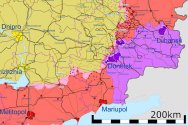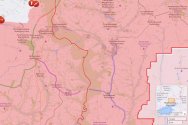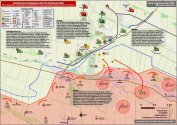Vuhledar it seems only a diversionary strike for the Russians and it does kind of makes sense that they did it half-assed
Do you know Radio Yerevan jokes? This reads like a setup for one of them.
Vuhledar is extremely important because of Russian logistical dependence on rail transport. Arguably everything that is currently happening on the front has three primary objectives aimed at re-establishing rail-based logistics to support the front.
Advances at Vuhledar, Bakhmut, Kreminna and Kupyansk are not random. They are necessary to re-establish railway connection behind a frontline that could be acceptable position for freezing of the conflict.
This is current fronline as of 25 Feb (Twitter/@WarMapper)

This is a more precise map of existing rail lines from liveuamap - green line emphasized main rail logistic route, red is missing section dismantled after 2014. Pay attention to the scale at bottom left of every map.

Currently there is just a single rail link connecting all of southern front (Kherson-Zaporozhia-Volnovakha) and it goes through Crimea. The northeastern front near Svatove is serviced by a single rail line from Valyuki/Urazovo in Russia. The frontline in DPR/LPR is serviced by a single rail line with two ends in Russia. This is a disjointed unworkable system that hampers Russian logistics at operational level. Russia doesn't have road transport like the US Army because it does not have an expeditionary army so whenever it can't use railways it can't perform operational maneuver which in this case is absolutely essential considering how the theater is shaped with Ukraine being positioned in the center and able to strike in all directions while Russia has to add hundreds if not thousand of kms to move troops and resources by rail.
Once Bakhmut is captured the pincer around Siversk will close and with capture of Siversk Russia would establish a coherent frontline that would be sustainable in the long term due to presence of rail route supporting it.
Similarly any offensive operations will be significantly easier with a continuous rail connection between sections of the front.
As for half-assing...
In the past I explained how Russia failed to prepare for and exploit geographic advantage near Dnester estuary leading to Transnistria and creation of second front south of Odessa. This is another of the "gems" of this invasion. Green and red indicate the same railway and missing section near Vuhledar/Volnovakha. However purple is a rail line that goes from Volnovaka to Andriivka and then to approx. 3-4km from the border with DPR! For seven years Russia didn't think to build an extension of the railway lines from Komsomolskye and Novoazovsk (south, off the map) which then would lead to Taganrog in Russia, near the border. If they built this line it would be trivial to establish even a temporary railway line to Myrne, Andriivka and Volnovakha and the problem of disruption of transit through Crimea would not be a problem. Smilarly Melitopol would not be such an extreme vulnerability.

Adding 200km of railways would change the entire front because of how presence of direct eastward rail link to Russia would enable staging of forces for operations.
Russia is pressuring along the entire frontline for that very reason.
As soon as they stop they lose the initiative and cede it to AFU. AFU will almost certainly concentrate forces, even at the cost of losing some ground in th east, and push toward Melitopol which lies ~70km south. Before they would capture a key junction which is will sever the only rail link for the entire southern front. Melitopol splits the front and practically puts Crimea in range.
Crimea is the decisive objective of this war.
If AFU reach Crimea then all logistics is disrupted, airfields and air defenses are under threat. Everything in air domain shifts eastward and then the very shallow southern front becomes untenable and will collapse under pressure.
Russia not only half-assed the entire plan of invasion. They thoroughly effed it up. They should have never been in this position. This is beyond incompetence. This is hubris.
------------
As for the assault at Vuhledar alone - this map from Twitter/@JominiW

What you have at Vuhledar is an entire Ukrainian 72nd mechanized brigade supported by 55th artillery brigade and elements of 68th Jaeger Brigade to the north east. Against it you have two Russian Marine Infantry brigades/regiments (40th and 155th), two exhausted motor rifle brigades (36th and 37th) and 72nd motor rifle brigade from the 3rd Army Corps (mobilized in summer).
However because of differences in structure between Ukrainian and Russian units you can't use equivalence.
Ukrainian mechanized brigades are larger and have five battalions: one tank, three mechanized and one light infantry (territorial defense). Each battalion is also larger and has four companies - three tank and one mech for tank battalion and one tank and three mech for mech battalion. Artillery brigade also has one light infantry battalion (TerDef) for protection.
Russian brigades use standard structure. Motor rifle (mechanized) and marine infantry brigade typically has one tank battalion (four companies - 40 tanks) and three mech battalions (three companies - 30 vehicles).
Ukrainian brigade has on average 50% to 100% more tanks and 30-40% more infantry. It's an equivalent of 1,5 to 2 Russian brigades.
Condition also matters. JominiW puts TOE (table of organization and equipment) markers on each unit. Red means that it has 40-54% of nominal TOE and yellow is 55-74%. Unit below 40% is considered incapable of combat operations and needs to be withdrawn from battle and can only serve as screening or rear security.
Also it could be understood like this:
Russian units have depending on TOE status 75+ % three BTG, 55-74% two BTG, 40-54% one BTG - available for rotation in combat (one at a time, two maximum)
Ukrainian units have 75+ % four BTG, 55-74% three BTG, 40-54% two BTG, 40% and below - one BTG but very weakened.
Ukrainians at Vuhledar have therefore three BTGs with support (potentially one BTG, and artillery), while Russians have four to six BTGs and two BTGs from exhausted 36th and 37th. Total six to eight maximum.
Russians are on the offensive meaning they need minimum of 2,5:1 proportion to be able to force defenders to withdraw and 3,5-4:1 to pursue and destroy withdrawing AFU units.
Russians are theoretically just under the minimum limit but AFU has good defensive position behind a canal and minefields meaning that any concentrated assault is hampered by disruption of tactical maneuver. Any temporary stop means taking fire which results in what we've seen on 6th Feb and just now.
Note that those casualties further limit Russian ability to generate numbers.
What would be necessary to break through defenses is aerial maneuver using helicopters but...
Russia - unlike e.g. Americans - doesn't have aviation brigades in each Combined Arms Army and the ground forces don't train helicopter operations. Only the VDV and select air assault battalions in Marine Infantry brigades (one per brigade) train helicopter ops. VDV is busy near Kreminna (76th and 7th), Bakhmut (98th and 106th) and the brigades have taken heavy losses and need to be reconstituted. There's also the lack of helos.
The helicopters are part of the VKS and are organized in separate army aviation brigades or regiments. Those regiments are too few and small in number to service an entire ground force all over Ukraine and by now should have lower readiness due to wear and losses. Last December a plan for expansion of the military was announced by the MoD and one of the points of this plan was creation of one army aviation per army - precisely to address this major problem. In theory Russia has sufficient number of helos to equip each army with at least a squadron or two but it never thought to do so because of internal rivalry between the branches - the reason why VKS got the helicopters even though it doesn't make any sense.
